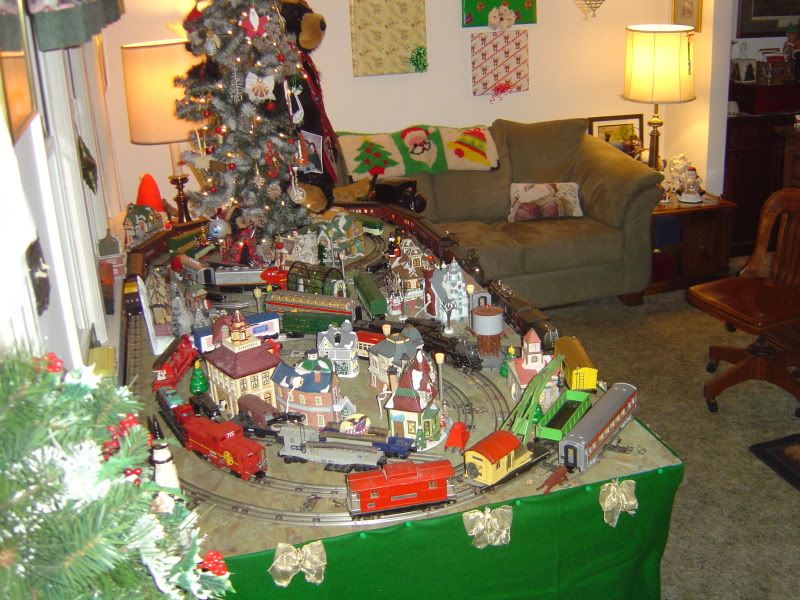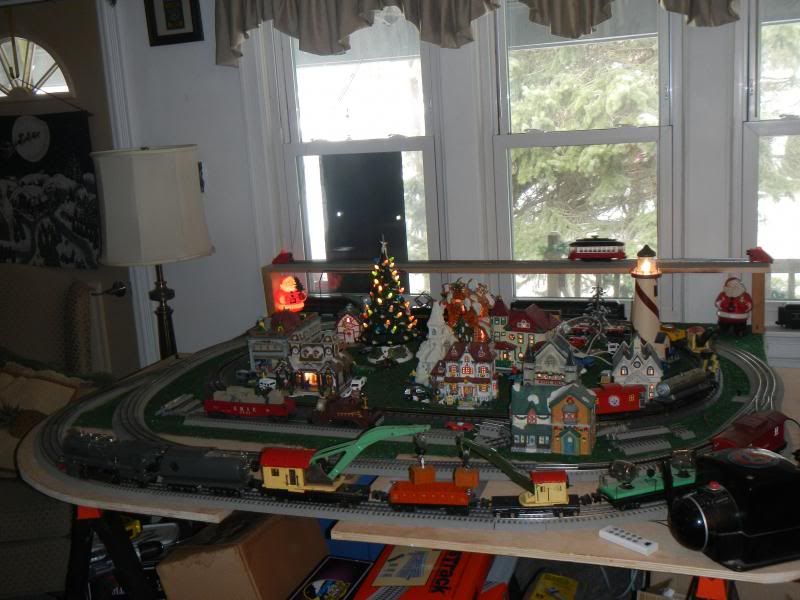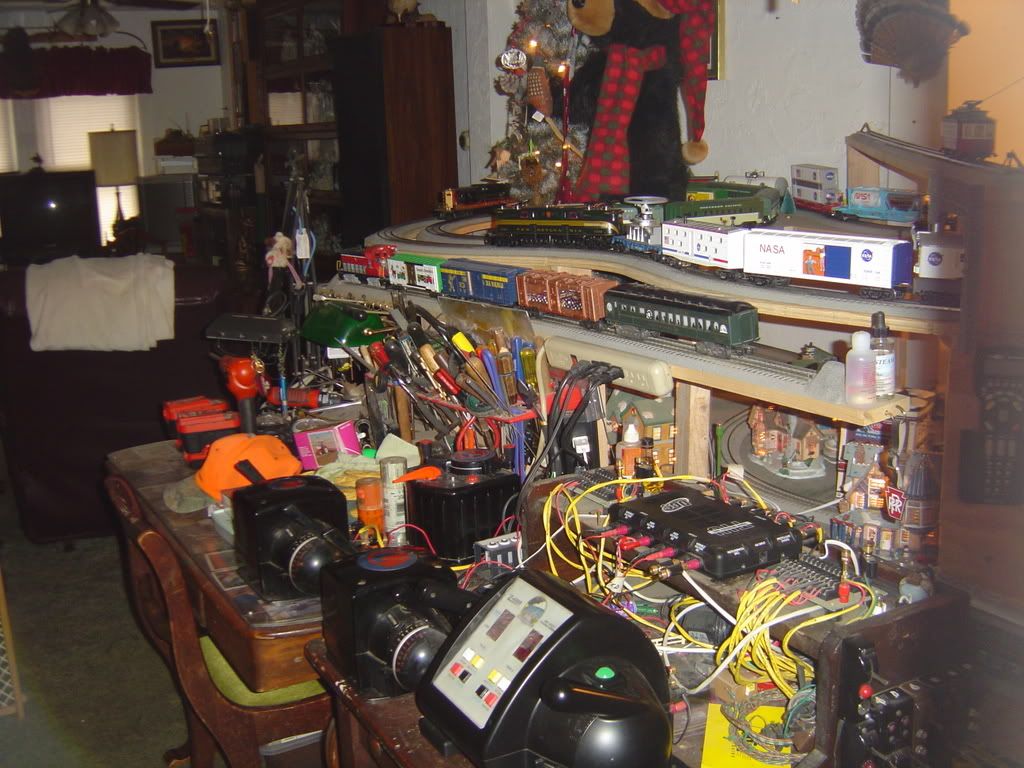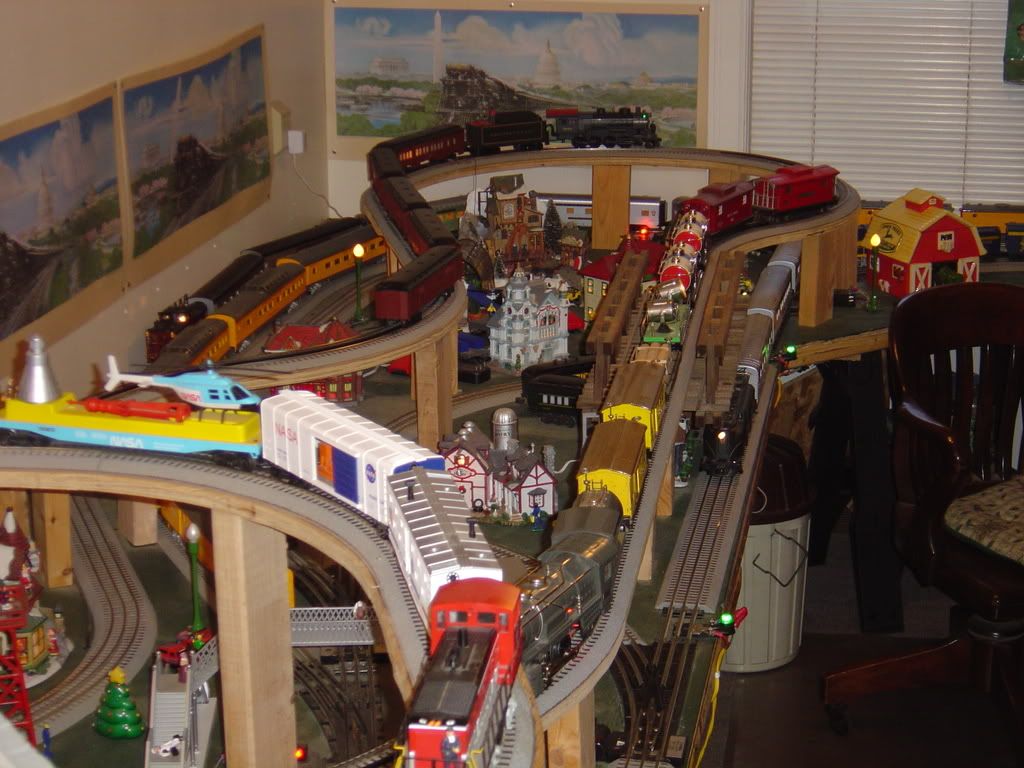Thanks all for the input. Appreciate it greatly. Two things I KNOW are going on - 1) Having been YEARS since I regularly ran conventional, especially with PS2/PS3 engines, I need a partial refresh. Plus, I don't remember such things going on but then again, its been a long time. 2) I've been in a "fog" since tearing my old layout down about a year & a half ago, a major regret, and have had nothing but problems with pretty much everything I've set up SO, I'm pretty much convinced I'm having issues even when I may not be.
Now.........
1) I am NOT using a ZW or Postwar anything. All modern stuff. Z-1000 power supplies, Lionel conventional, LC+, MTH PS2/PS3 engines.
2) Tubular track, 0-27 profile.

Here is a shot of what I'm currently working with. Inner loop is 0-27 curves with the 35" rigid straight on the right and a few standard sections on the left to accommodate the switch. Outer loop is 0-42 with two of the 35" rigid straights on each side. Pretty simple. (Ignore DCS set up).
Inner loop runs fine with engines such as PS2/3 with cruise but I run that loop pretty slow, about 10-15 MPH if using DCS, estimated with conventional of course. Outer I run about 35 with DCS, estimated again with conventional.
Outer loop runs OK with cruise, nothing exciting until I blow the whistle, etc. Inner has two power feeds (18 gauge wire, not the best but the best I could get my hands on and work with). One feed right before the switch and the other by the caboose. Outer has 4 feeds. One right at transformer on left, one about 2 curve sections into the curve at the top, by the diesel sitting on the side, another near the 2 passenger cars and boxcar (right under middle passenger car) and the final right at the bottom right on the curve (visible in photo). All feeds are 5 track sections apart except the one in the bottom right which is 4 sections from the next behind the transformer. Again, 18 gauge wire. I think both loops have about as many feeds as they reasonably can handle and should have.
Again, running cruise, etc in "standard mode" on the inner loop isn't an issue. Turning cruise off on inner found a lot of slow spots that I couldn't see with my sole non-cruise engine which runs at about Mach 2, even at the slowest transformer setting.
Outside, frequent whistle/bell presses can jump the speed a bit, such as the crossing (long-long-short-long) where voltage jumps around 2 volts at each button press. Particular on the right side, approximately from the boxcar at upper right to the curve at the lower right. Not every whistle/bell press results in speed adjustments. Only when done quickly. I assume, and please correct if wrong, the speed jump is caused the the frequent button pressing and the engine responding as a result to quick, approx. 2 volt changes? Turning the cruise off on PS3/2 engines, I found things to run a bit quicker in that section and SLIGHTLY slower around the rest of the loop (and I mean slightly). I only have one non-cruise engine available, a simple Lionel RTR 4-4-2 but it's slow speed is more Nascar speed so it is hard to monitor but it responds the same - slightly quicker on right, slightly slower on left. I also think the speed adjustments are particular noticeable due to chuff speed rapidly increase or diesel roar increase then drop. Also can hear wheels on the track pick up speed.
I'm generally concerned that this outer loop isn't really performing the way it should in the following ways:
1) Speed jumps, especially on right side while frequent whistle/bell presses. Seems to vary slightly in intensity depending on running slow (less juice) vs fast (more juice). Just "the way it is" with high/low voltage depending on operation?
2) One engine (PS2 SW1) seems more responsive to whistle/bell vs others (PS3 0-6-0 & Dash 8). My two other PS2 steamers are not available currently due to repairs unknown how they will perform (hopefully flawlessly!)
3) Concern over longterm operation with voltage variations, particularly with the MTH engines and $$$ electronics. - bad? No Big deal? So far, seems like no big deal.
4) My thought process is that any engine with speed control should not at all vary its speed regardless of whistle/bell or just rolling along. Perhaps I've been in command control with solid 18 volts too long....?
6) For example, lets say I'm running at 10 volts. Push the whistle, voltage jumps to approx. 11.2 - 11.5 volts. Release and immediately press again, voltage stops dropping and jumps back, sometimes hitting 12 or a bit higher. This is when the engines may start to jump a bit then fall back. Waiting about 2 seconds between button presses doesn't get this. I also tested in this way - get things running. Again, lets use 10 volts as an example. Push whistle, speed climbs to point A. Speed drops upon button release. Do not touch whistle, etc. Turn speed control dial on Z-1000 so voltage climbs to the point hit when whistle/bell press. Train runs substantially faster when voltage is turned up to that point vs when it reaches that point with whistle/bell. Normal?
Thats all I can think of at this point. I'm going to see if I can borrow a friends Williams GP9 to try out also and see how it runs, really just out of curiosity. Sorry for the long winded post. Haven't run trains like this, literally, in 10+ years. Been command control 100% of the time since.







